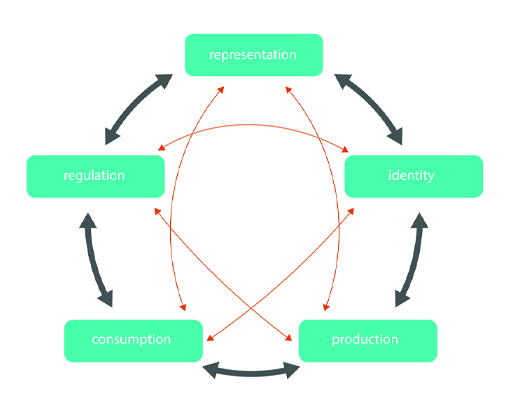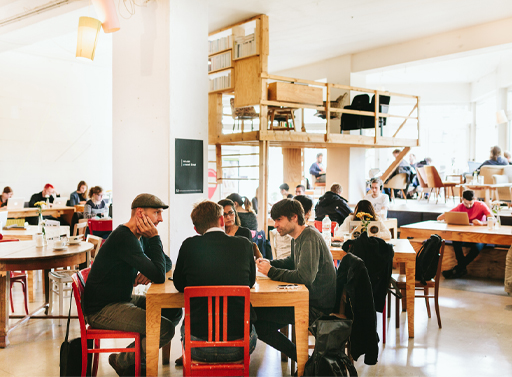1.1 The five major cultural practices
Du Gay, Hall, Janes, Madsen, Mackay and Negus (1997) identify five major cultural practices, which are interrelated by the articulations between them (see Figure 3). This is represented diagrammatically as five nodes (in no particular order) connected by arrows.
Articulations reflect how culture is produced and exchanged through movement between the five practices. In other words, we interact with each of these interrelated practices to produce and exchange meanings from them. Let’s examine each practice in turn, using a straightforward organisational example of the monthly departmental meeting.
Representation
‘Representation is the practice of constructing meaning through the use of signs and language’ (Du Gay et al., 1997, p.170). What is represented by a monthly departmental meeting? What does it signify? Beyond sharing information, it is an opportunity for departmental members to catch up and share stories. It is a formal, yet important regular event that represents shared understandings of what it means to work together.
Identity
Department members’ identity practices at the monthly meeting are equally important and observable. Members will each identify themselves differently, taking on particular roles, such as the meeting chair, secretary, etc. Some might group together, while others sit alone. Some may be vocal and others less so.
Production
Production in a departmental meeting involves practices of disseminating information, making decisions and agreeing on future actions. How those are achieved in practice are cultural. Production, in this example, can be thought of in terms of how information is communicated, how decisions are made, and how actions are agreed.
Consumption
Consumption in this example is about the practices of how information is consumed by those present. Different departmental members will likely consume information differently, perhaps noting down and taking away only what they need to know.
Regulation
Finally, regulation involves the practices of formally (and informally) conducting the meeting. The departmental meeting will likely be required to be chaired by the manager or a senior member of the department and minuted for future reference. Less formal practices of regulating the meeting will likely follow particular traditional cultural norms built up by departmental members over time. For example, when a question is put to all members, perhaps junior members might wait for more experienced departmental members to answer first.
None of these five practices operates in isolation. The outcomes of the meeting will depend on the articulations between each of these cultural practices before, during and after that moment. Hence, every meeting will be different.
Activity 2 Learning to analyse organisational culture
Part A
According to Du Gay, Hall, Janes, Madsen, Mackay and Negus (1997), there are five organisational culture practices:
- Representation
- Identity
- Production
- Consumption
- Regulation
Using the circuit of culture that you have just learned about, drag and drop the cultural practice that you think fits each of the following questions/statements.
Using the following two lists, match each numbered item with the correct letter.
-
REPRESENTATION
-
PRODUCTION
-
IDENTITY
-
REGULATION
-
CONSUMPTION
a.The cultural practice of how space in a workplace is defined or divided up by the designer and how workers interact in it
b.The cultural practice of how things are communicated or analysed in a workplace
c.The cultural practice of what work looks and feels like in a workplace
d.The cultural practice of the ways workers portray themselves in the workplace
e.The cultural practice of how workers use space in a workplace
- 1 = c
- 2 = b
- 3 = d
- 4 = a
- 5 = e
Part B
Now, look at Figure 2 of a workspace again.
Based on your observations, how would you describe the culture of this workspace using the five culture practices (i.e. representation, identify, production, consumption and regulation)?
Feedback
What did you observe? Here is one interpretation of the question:
- Representation: This space is light and airy. It looks like people can choose to use it in different ways, depending on what they need to do.
- Identity: The people are dressed casually. Each is engaged in what they are doing. Everyone seems to be focused, and some appear to be enjoying their work.
- Production: Most people are using laptops or smart devices; two are in conversation – probably having a meeting. The two people at the front seem engrossed in what they are doing. They might be checking email, working on a document, or analyzing some data. Production is, therefore, more likely to be focused on knowledge as it is not visible in a material sense; for example, if the photograph were of an assembly line, we would be able to see the output, such as chocolate bars.
- Consumption: People are using different areas in space. Some are working alone, others are having a meeting, and the two people at the back may be either working or taking a break.
- Regulation: Space is designed to provide different areas to work or take a break. It is an open plan and designed for sharing. There are comfortable chairs as well as desks. The balcony on the left may offer an alternative space to work.
Part C
So, based on your observations, how would you describe the culture of the workspace?
Feedback
Based on these observations, the culture of this workspace could be described as open, flexible, and inviting. It enables people to interact or work alone – a space where a diversity of people would feel comfortable working. The image can be summarised as a representation of a contemporary pluralistic organizational culture.
You have learned a straightforward way to analyse an image of organisational culture. You probably do this sort of thing every day instinctively, in a more taken-for-granted way. However, it is important to reflect on hidden complexities around what you might take for granted through observation. How much of what goes on in your day to day working practices are not visible? Representations of transparency can also be a mechanism for hiding a plurality of political realities and contradictions. Are there any private spaces to ‘hide’ in this workspace? What are the implications in terms of surveillance?


